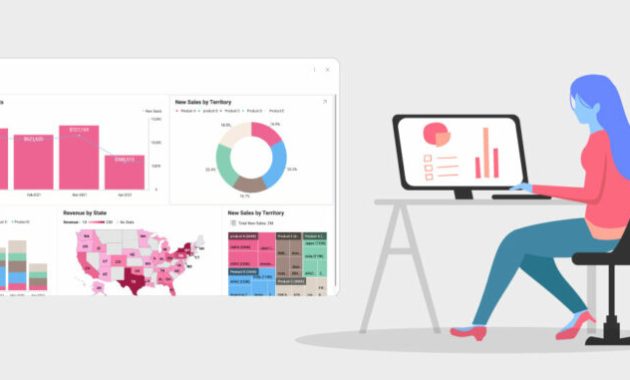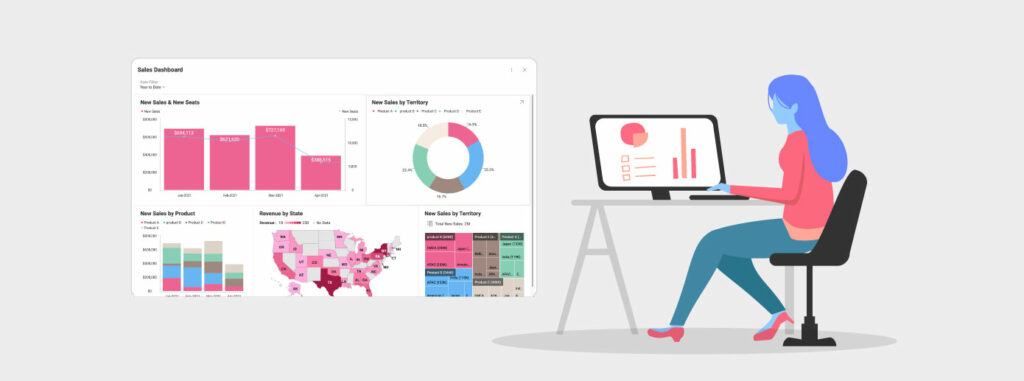
Self-Service Business Intelligence Software: Empowering Users, Transforming Businesses
In today’s data-saturated world, businesses are drowning in information. The challenge isn’t a lack of data, but rather the ability to extract meaningful insights quickly and efficiently. This is where self-service business intelligence software steps in, providing a powerful solution to transform raw data into actionable intelligence. This article explores the capabilities of self-service business intelligence software, its benefits, and how it’s reshaping the landscape of data analysis.
The Evolution of Business Intelligence
Traditional business intelligence (BI) often involved complex processes, requiring specialized technical skills. Data analysts were the gatekeepers, creating reports and dashboards for business users. This model was time-consuming, created bottlenecks, and often resulted in delayed decision-making. Self-service business intelligence software emerged as a response to these limitations. It empowers business users to access, analyze, and visualize data independently, without relying on IT or data specialists for every request. This shift represents a fundamental change in how organizations approach data analysis.
What is Self-Service Business Intelligence Software?
Self-service business intelligence software is a type of BI tool that enables users with little to no technical expertise to perform data analysis and create reports, dashboards, and visualizations. These tools typically offer a user-friendly interface, drag-and-drop functionality, and pre-built templates, making data analysis accessible to a wider audience. Key features often include:
- Data connection and integration: Connecting to various data sources, including databases, spreadsheets, and cloud applications.
- Data preparation: Cleaning, transforming, and preparing data for analysis.
- Data visualization: Creating charts, graphs, and dashboards to visualize data insights.
- Reporting and sharing: Generating reports and sharing them with colleagues or stakeholders.
- Advanced analytics: Offering features like predictive analytics and data mining.
These features combine to offer users the ability to quickly and easily gain insights from their data, leading to better decisions and improved business outcomes.
Key Benefits of Self-Service BI
The advantages of implementing self-service business intelligence software are numerous and far-reaching. Here are some of the most significant:
- Faster Decision-Making: Users can access and analyze data in real-time, enabling quicker responses to market changes and business opportunities.
- Improved Data Literacy: The intuitive nature of these tools fosters a data-driven culture, enhancing data literacy across the organization.
- Reduced IT Burden: By empowering business users, self-service business intelligence software frees up IT resources to focus on more strategic initiatives.
- Increased Efficiency: Automating data analysis and reporting tasks streamlines workflows and saves time.
- Enhanced Collaboration: Data-driven insights can be easily shared and discussed, promoting collaboration and alignment across teams.
- Cost Savings: Reduced reliance on specialized analysts can lead to significant cost savings.
Choosing the Right Self-Service BI Software
Selecting the right self-service business intelligence software is crucial for success. Several factors should be considered during the evaluation process:
- Ease of Use: The software should have an intuitive interface and user-friendly features.
- Data Connectivity: It should support connections to all relevant data sources.
- Data Visualization Capabilities: The tool should offer a wide range of visualization options.
- Reporting and Sharing Features: It should allow for easy report generation and sharing.
- Scalability: The software should be able to handle increasing data volumes as the business grows.
- Security: Data security and access control are paramount.
- Pricing: Consider the cost of the software and its features.
Researching and comparing different software options is essential to find the best fit for your organization’s specific needs. Consider a free trial to test out the features.
Real-World Applications: Examples of Clarity in Action
Self-service business intelligence software is used across a wide range of industries and departments. Here are a few examples:
- Retail: Analyzing sales data to identify best-selling products, optimize pricing, and improve inventory management.
- Marketing: Tracking campaign performance, identifying customer segments, and measuring ROI.
- Finance: Monitoring financial performance, identifying trends, and creating financial reports.
- Healthcare: Analyzing patient data to improve care, optimize resource allocation, and identify areas for improvement.
- Manufacturing: Monitoring production processes, identifying inefficiencies, and optimizing supply chains.
These are just a few examples of how self-service business intelligence software is bringing clarity to data and enabling data-driven decisions.
Data Preparation for Self-Service BI
While self-service business intelligence software simplifies data analysis, data preparation remains a critical step. The quality of the insights depends on the quality of the data. Data preparation involves cleaning, transforming, and structuring data to make it suitable for analysis. This includes:
- Data Cleaning: Removing errors, inconsistencies, and missing values.
- Data Transformation: Converting data into a usable format.
- Data Integration: Combining data from multiple sources.
- Data Enrichment: Adding additional data to enhance insights.
Many self-service business intelligence software solutions offer built-in data preparation features, but understanding the importance of this step is essential for accurate analysis.
The Future of Self-Service BI
The future of self-service business intelligence software looks bright. Advancements in artificial intelligence (AI) and machine learning (ML) are poised to further enhance the capabilities of these tools. We can expect to see:
- Automated Insights: AI-powered features will automatically identify trends and patterns in data.
- Natural Language Processing (NLP): Users will be able to ask questions in plain language and receive answers in the form of visualizations or reports.
- Increased Integration: Seamless integration with other business applications will become the norm.
- Enhanced Collaboration: Improved collaboration features will facilitate data sharing and discussion.
These advancements will make self-service business intelligence software even more accessible and powerful, further empowering business users to leverage data for better decision-making.
Implementing Self-Service BI: A Step-by-Step Guide
Implementing self-service business intelligence software requires a strategic approach. Here’s a step-by-step guide:
- Define Your Goals: Identify the key business questions you want to answer.
- Choose the Right Software: Select the software that best fits your needs and budget.
- Prepare Your Data: Clean, transform, and structure your data.
- Train Your Users: Provide training and support to ensure users can effectively use the software.
- Establish Data Governance: Implement policies and procedures to ensure data quality and security.
- Monitor and Evaluate: Track the use of the software and measure its impact on your business.
Following these steps can increase the likelihood of a successful implementation.
The Impact of Self-Service Business Intelligence Software
The impact of self-service business intelligence software is far-reaching. It empowers businesses to make data-driven decisions, improve efficiency, and gain a competitive edge. By democratizing data access and analysis, these tools are transforming the way organizations operate. The ability to quickly obtain and analyze data is crucial in today’s competitive landscape. Self-service business intelligence software offers a solution to this need.
Conclusion: Embracing Data Clarity
Self-service business intelligence software is a powerful tool for businesses seeking to gain clarity from their data. By empowering users, streamlining analysis, and fostering a data-driven culture, these tools are transforming the way organizations make decisions. As technology continues to evolve, self-service business intelligence software will play an increasingly important role in helping businesses thrive in the data age. The ability to translate data into actionable insights is now more accessible than ever. Embracing self-service business intelligence software is a key step toward achieving data clarity and driving business success. [See also: Choosing the Right BI Tools]

